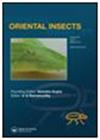2014年大鲵(Mylabris cernyi Pan & Bologna)消化道和排泄系统的解剖组织学描述(鞘翅目:蝇科)
IF 0.6
4区 农林科学
Q4 ENTOMOLOGY
引用次数: 2
摘要
摘要在本研究中,我们用光镜和扫描电镜对米拉布里斯(Mylabris cernyi)的消化道和排泄系统进行了组织学和解剖学研究。消化道分为三部分:前肠、中肠和后肠。前肠包括咽、食道、前心室和食道瓣膜。前肠部分有肌层、薄上皮和内膜。中肠发育良好,具有横向褶皱的形状。柱状细胞上皮内翻形成大而深的上皮组织褶皱。后肠有幽门、回肠、结肠和直肠。在后肠的细胞层中,有角质层内膜的内衬、上皮层和肌肉层。在中肠和后肠之间有6个马氏小管。研究结果将有助于指导制定管理这种有害生物的新战略。因为了解该物种的消化和排泄系统的精细结构对于形成对该物种进行农业控制研究的基础非常重要。本文章由计算机程序翻译,如有差异,请以英文原文为准。
Anatomical and histological descriptions of digestive canal and excretory system of Mylabris cernyi Pan & Bologna, 2014 (Coleoptera: Meloidae)
ABSTRACT In the present study, we described the histological and anatomical studies of the digestive canal and excretory system of Mylabris cernyi with light and scanning electron microscopies. The digestive canal is divided into three parts: the foregut, the midgut, and the hindgut. The foregut includes a pharynx, an oesophagus, a proventriculus and an oesophageal valve. There are the muscle layer, a thin epithelium, and the intima lining in the parts of the foregut. The midgut is well developed and has a transversely wrinkled shape. This epithelial layer of columnar cells is invaginated to form large and deep folds of epithelial tissue. The hindgut has pyloric valve, ileum, colon, and rectum. In the cell layers of the hindgut, there is an inner lining of the intima of cuticula, an epithelial layer and a muscle layer. There are 6 Malpighian tubules which are attached between the midgut and the hindgut. The results will help guide the development of new strategies for managing this pest. Because knowing the fine structure of the digestive and excretory system of this species is important in terms of forming the basis for the studies to be carried out in agricultural control against this species.
求助全文
通过发布文献求助,成功后即可免费获取论文全文。
去求助
来源期刊

Oriental Insects
生物-昆虫学
CiteScore
1.60
自引率
0.00%
发文量
34
审稿时长
>12 weeks
期刊介绍:
Oriental Insects is an international, peer-reviewed journal devoted to the publication of original research articles and reviews on the taxonomy, ecology, biodiversity and evolution of insects and other land arthropods of the Old World and Australia. Manuscripts referring to Africa, Australia and Oceania are highly welcomed. Research papers covering the study of behaviour, conservation, forensic and medical entomology, urban entomology and pest control are encouraged, provided that the research has relevance to Old World or Australian entomofauna. Precedence will be given to more general manuscripts (e.g. revisions of higher taxa, papers with combined methodologies or referring to larger geographic units). Descriptive manuscripts should refer to more than a single species and contain more general results or discussion (e.g. determination keys, biological or ecological data etc.). Laboratory works without zoogeographic or taxonomic reference to the scope of the journal will not be accepted.
 求助内容:
求助内容: 应助结果提醒方式:
应助结果提醒方式:


